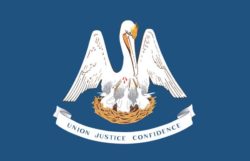Sebastian Calvo de la Puerta Y O’Farrill, marqués de Casa Calvo
After the death of Governor Manuel Gayoso de Lemos in July 1799, Casa Calvo was sent to Louisiana to serve as interim governor of the Spanish colony.
Following the death of Manuel Gayoso de Lemos y Amorin, Spanish military officer Sebastián Calvo de la Puerta Y O’Farrill, marqués de Casa Calvo was appointed interim governor of Louisiana on September 18, 1799. His term was extended until 1801, when illness delayed his successor’s arrival. Holding office in a period marked by increasing tensions between the United States and Spain, Casa Calvo spent much of his time and energy fighting to keep Americans out of Spanish Louisiana—a task that ultimately proved doomed to failure.
Sebastián Calvo de la Puerta y O’Farrill, marqués de Casa Calvo was born in Havana c. 1751 to a wealthy family of Cuban nobles. He attended private schools until entering the army’s Company of Nobles as a cadet at age thirteen. His rise through the military ranks began in 1769, when he purchased a commission as captain of cavalry volunteers. By 1794, he had achieved the rank of brigadier. Casa Calvo participated in General Alejandro O’Reilly’s 1769 expedition to New Orleans, as well as in the sieges of Mobile (1780), Pensacola (1781), and Providence (1782). He acquired his noble title and was knighted in the Order of Santiago in 1786. Later, in 1794, his warships successfully engaged the French enemy in St. Domingue.
After the death of Governor Manuel Gayoso de Lemos in July 1799, Casa Calvo was sent to Louisiana to serve as interim governor of the Spanish colony. His successor, Juan Manuel de Salcedo, was delayed by illness, leaving Casa Calvo to deal with conflicts within the local government, as well as military problems. Although Casa Calvo attempted to keep the government flowing smoothly, conflicts among local officials—particularly Nicolas Maria Vidal, the ad interim civil governor, and members of the Cabildo—made this difficult. Military problems included British threats to invade from Canada, a blockade of the mouth of the Mississippi River that impeded trade and communications with Havana, and Native American organizer William Augustus Bowles’ 1800 capture of Fort San Marcos de Apalache in West Florida. In addition, a lack of funds, coupled with the decline of the Fixed Louisiana Regiment, left Casa Calvo unable to prevent Americans from entering Louisiana at will.
Salcedo finally arrived and assumed office on July 14, 1801, but Casa Calvo continued to play an active role in Louisiana politics. In 1803 he returned to New Orleans to assist Governor Salcedo as he turned Louisiana over to France (which subsequently turned the territory over to the U.S. in the Louisiana Purchase). He remained in the area as commissioner of limits for more than two years. As such, he worked to determine the new boundary between Spanish Texas and the United States and prevent American encroachment on Spanish territory. As an advocate of Spanish interests, Casa Calvo became a thorn in the side of American governor William C. C. Claiborne, who ordered his departure in 1806.
After he left Louisiana, Casa Calvo traveled to Spain, where he sided with Joseph I—the intrusive French king sitting on the Spanish throne in 1808—and became a lieutenant general in the king’s army. Upon the defeat of the French, Casa Calvo left Spain in disgrace and ended his life exiled in Paris. While the precise date of his death is unknown, he appears to have died in May 1820.
Adapted from Gilbert C. Din’s entry for the Dictionary of Louisiana Biography, a publication of the Louisiana Historical Association in cooperation with the Center for Louisiana Studies at the University of Louisiana, Lafayette.
Sources: Arthur Preston Whitaker, The Mississippi Question, 1795-1803 (1934, reprint ed., 1962); Ronald R. Morazan, “Letters, Petitions, and Decrees of the Cabildo of New Orleans, 1800-1803” (Ph. D. dissertation, Louisiana State University, 1972).
